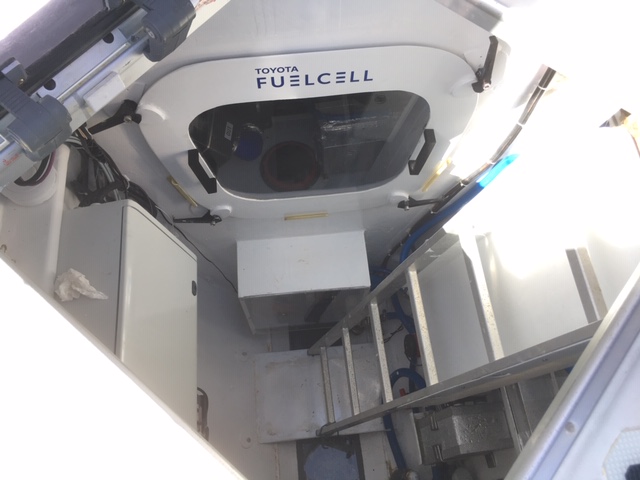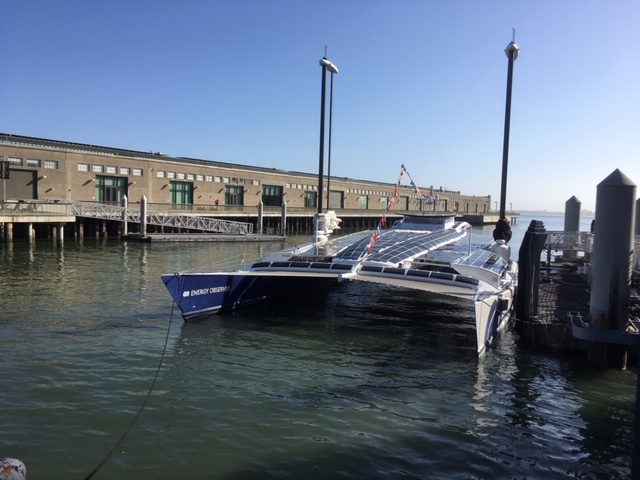Katia Nicolet, chief scientist for the Energy Observer, provided a tour and an overview of the renewable energy powered catamaran that arrived at the Port of San Francisco on May 6th and is on its way to Hawaii and Japan.
Since setting sail from Saint Malmo, France in 2017, the 100-foot catamaran has already navigated over 35,000 nautical miles powered by renewable energy. The backers of the Energy Observer describe the vessel as “a working laboratory designed to push the envelope with zero emission technologies.”
The main backers of the Energy Observer project are: Accorinvest, Thelem, Delanchy, Engie, Toyota, and CGM CMA.
The Energy Observer is operated by a five-person crew including Victorien Erussard, the founder and captain, plus a chief engineer and a boatswain. In addition, there is a reporter who generates progress reports on the voyages and the Chief Scientist Katia Nicolet.
Nicolet explained the EO’s mission: “We have a prototype ship so it's really a pioneer sister and we showcase all different types of renewable energy that are available today … and that they can sustain our ships in the worst type of environment.”

Renewable Energy Power
She explained the solar power components and the impact on the electric motors: “We have three different types of solar panels and as you can see, they cover almost all of the surfaces of the ship. The solar panels charge the batteries and as long as we have sunny weather, we can power the electric motors. The solar panels generate 126 kWh (kilowatt hours) which provides 100% of the vessel’s electric motors and 26 kWh for light, heat, the coffee machine, dishwasher and washing machine.”
The Energy Observer is propelled by two electric motors, each with 42 kW capacity, providing a total of 115 horsepower. The optimal speed for the Energy Observer is 4.5 knots. One of the advantages of the Energy Observer’s electric motors is that they are reversible: they can generate a complement of electricity up to twice 4 kW, according to the website.
Hydrogen Fuel Cells
Nicolet explains how the hydrogen fuel cell system works:
“On the days we don’t have good weather, we use hydrogen fuel cells. The ship is equipped with a desalinator and an electrolyzer. The salt water needs to be purified before having its hydrogen and oxygen separated. We make the hydrogen through a process of electrolysis using fresh water that we source when we desalinate the salt water and derive fresh water. Our hydrogen is made using solar power and is a green hydrogen product unlike using non-green sources using fossil fuels. The hydrogen is stored in 8 tanks that collectively produce 1 MW of electricity that can power the ship for six days.”

When there is not enough solar power or hydrogen fuel cell power, the third source of power is derived from the wind captured by two sails hoisted on two masts located on the port and starboard sides of the vessel. The sails require a minimum of 10 knots of wind to propel the Energy Observer, she said.
Nicolet said the Energy Observer sources only renewable energy to power the vessel on an annual basis:
- 40% Solar
- 40% Wind
- 20% Hydrogen Fuel Cell
The Energy Observer will leave San Francisco and sail to Hawaii a voyage that will take about two weeks. Following Hawaii, the Energy Observer will sail to Japan.
Toyota is a major backer of the Energy Observer and has built the hydrogen fuel cell technology used to power the Energy Observer.
Toyota also builds the hydrogen fuel cell powered automobile, the Mirai. The company recently announced that for 2021:
“Toyota has fully rebooted the Mirai as a premium rear-wheel drive sports-luxury FCEV with striking design, cutting-edge technology … The model’s name, which means future in Japanese, is wholly appropriate, as the 2021 Mirai is powered by the latest evolution of the brand’s advanced fuel cell electric vehicle (FCEV) powertrain. The new Mirai is one part of an electrification strategy that also includes Toyota’s current and future hybrids and upcoming battery electric vehicles (BEVs). Toyota put the auto industry on the road to modern electrification in 1997 with the first Prius hybrid…”

Challenges Facing Hydrogen Fuel Cells
However, there are several major problems facing the utilization of hydrogen fuel cells in cars and trucks as AJOT’s Matt Miller pointed out last December:
The first problem is high cost: “At an average cost of diesel these days running about $2.37, that means hydrogen is at best almost four times as expensive as a fuel source and twice as expensive in terms of miles traveled.”
The second problem is availability: “According to the US Department of Energy and the California Air Resources Board, there are now 43 public hydrogen fueling stations nationwide, of which 42 are located in California, with Connecticut having one as well. (Plug-in battery recharge stations, by contrast, totaled 78,300 last year, according to the Department of Energy.) New hydrogen stations aren’t cheap to build, either, with costs of at least $2 million each, according to the California Fuel Cell Partnership.”
The third challenge is that in the United States almost all hydrogen fuel utilizes fossil fuel and is not therefore a renewable energy: “In the US, almost all hydrogen now is produced from natural gas, which means it indirectly is dependent on fossil fuel and contributes to carbon dioxide emissions. The hope is that long-term, renewables such as solar and wind will provide the energy needed to create the hydrogen gas through a process called electrolysis and that fuel stock costs will drop dramatically.”
As Nicolet observed, this last challenge is where the technology onboard the Energy Observer is demonstrating the successful use of solar power to generate hydrogen.
She says the Energy Observer provides the laboratory that shows how the global maritime industry can achieve zero-emission ships sometime in the future.

